|


Unless otherwise stated:
Domain:  (All Reals) (All Reals)
Range:  (All Reals) (All Reals)
|
Equation Forms:
• Slope-Intercept Form:
y = mx + b
m = slope; b = y-intercept
• Point-Slope Form:
y - y1 = m(x - x1)
uses point (x1,y1) and m
• Standard Form:
Ax + By = C
A, B and C are integers.
A is positive.
|
|
Finding Slope:

Average rate of change (slope) is constant. |
| No relative or absolute maxima or minima unless domain is altered. |
x-intercept (for y = x):
crosses x-axis
(x, 0)
Set y = 0, solve for x.
y-intercept (for y = x):
crosses y-axis
(0, y)
"b" value
Set x = 0, solve for y.
End Behavior:
One end approaches +∞,
other end approaches -∞.
(Unless domain is altered.)
|
Effects of Changes in y = mx + b: (m = slope; b = y-intercept)
• if m = 0, then line is horizontal (y = b)
• if m = undefined, then line is vertical ("run" =0) (not a function)
• if m > 0, the slope is positive (line increases from left to right)
(the larger the slope the steeper the line)
• if m < 0, the slope is negative (line decreases from left to right)
• Lines with equal slopes are parallel.
• | m | > 1 implies a vertical stretch
• -1 < m < 0 or 0 < m < 1, implies a vertical shrink
• if b > 0, then there is a vertical shift up "b" units
• if b < 0, then there is a vertical shift down "b" units |
|
Linear Function - Transformation Examples:
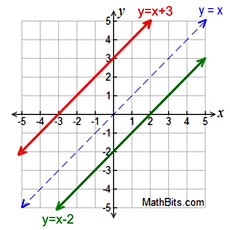 Translations
Translations |
Translations:
Vertical Shift: f (x) + k
Horizontal Shift: f (x + k)
Reflections:
-f (x) over x-axis
f (-x) over y-axis
|
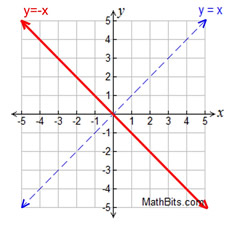
Reflection |
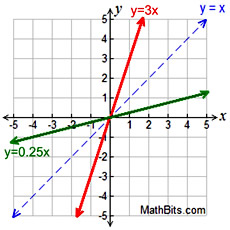
Vertical Stretch/Compress |
Vertical Stretch/Compress
k • f (x) stretch (k > 1)
k • f (x) compress (0 < k < 1)
Horizontal Stretch/Compress
f (k • x) stretch (0 < k < 1)
f (k • x) compress ( k > 1) |
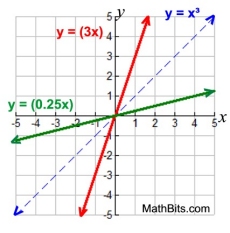
Horizontal Stretch/Compress |
 For straight lines, For straight lines,
•
a vertical stretch of a factor of k is equivalent to a horizontal compression by a factor of k.
•
a vertical compression by a factor of k is equivalent to a horizontal stretch by a factor of k.
Both of these statements result in the same function.
Consider:
Given f (x) = x, a vertical stretch of k = 2, gives 2(f (x)) = 2x.
But a horizontal compression of k = 2, gives f (2x) = 2x. |
As a result, the transformations of vertical stretch/compress and horizontal stretch/compress are seldom referenced in relation to straight lines. Instead, references are made to changes in slope.

 Shape: Parabola Shape: Parabola
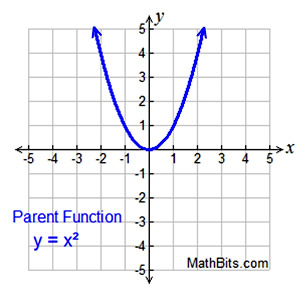 Symmetric about the y-axis.
Turning point (minimum) at (0,0). Symmetric about the y-axis.
Turning point (minimum) at (0,0). |
Equation Forms:
• Vertex Form:
y = a(x - h)2 + k
with
vertex (h,k)
easy access to finding vertex, max/min, inc/dec
• Point-Slope Form:
y = ax2 + bx + c
shows general form of graph and roots (zeros)
• Intercept Form:
y = a( x - p)( x - q)
p and q are x-intercepts.
shows roots, pos/neg
|
|
Axis of Symmetry:
 locates "turning point"
locates "turning point"
(vertex)
Average rate of change
NOT constant
x-intercept(s):
determine roots/zeros
y-intercept:
(0, y)
|
| End Behavior: |
Parent Function: f (x) = x²
as x → + ∞, f (x) → + ∞
as x → - ∞, f (x) → + ∞
parabola opens upward
|
Negative Coefficient: f (x) = -x²
as x → + ∞, f (x) → - ∞
as x → - ∞, f (x) → - ∞
parabola opens downward
|
The quadratic function y = x2 is an even function: f (-x) = f (x) |
Quadratic Function - Possible Real Roots and Complex Roots:
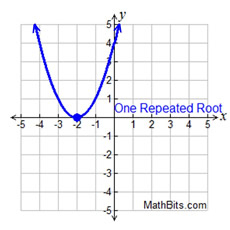 y = (x + 2)(x + 2)
y = (x + 2)(x + 2)
x = -2; x = -2
Repeated root
Multiplicity 2 |
 y = (x - 2)(x + 2)
y = (x - 2)(x + 2)
x = 2; x = -2
Each root is
multiplicity 1 |
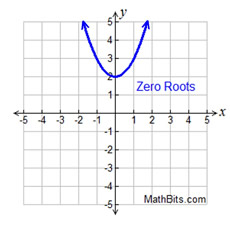 y = x² + 2
y = x² + 2

roots are complex (imaginary)
|
Maximum/Minimum: Finding the "turning point" (vertex) will locate the maximum or minimum point. The intervals of increasing/decreasing are also determined by the vertex.
Quadratic Function - Transformation Examples:
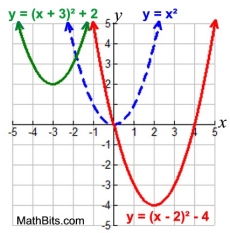 Translations
Translations |
Translations:
Vertical Shift: f (x) + k
Horizontal Shift: f (x + k)
Reflections:
-f (x) over x-axis
f (-x) over y-axis
|
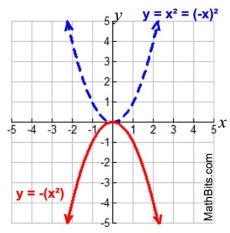
Reflection |
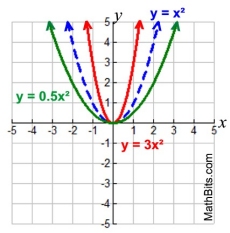
Vertical Stretch/Compress |
Vertical Stretch/Compress
k • f (x) stretch (k > 1)
k • f (x) compress (0 < k < 1)
Horizontal Stretch/Compress
f (k • x) stretch (0 < k < 1)
f (k • x) compress ( k > 1) |
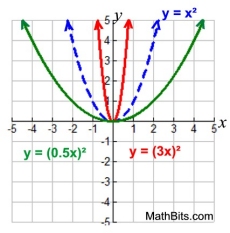
Horizontal Stretch/Compress |
Remember: for y = ax2 + bx + c, negative "a" opens down.

 Cubic functions are of degree 3.
Cubic functions are of degree 3. |
Example Equation Forms:
• y = x3
(1 real root - repeated)
• y = x3- 3x2= x2(x - 3)
(two real roots - 1 repeated)
• y = x3+2x2+x = x(x + 1)2
(three visible terms)
• y = x3+3x2+3x+1=(x+1)3
(1 real root - repeated)
• y = (x+1)(x - 2)(x - 3)
(factored form - 3 real roots)
|
|
Symmetric (for y = x³):
about origin
Average rate of change:
NOT constant
x-intercept(s):
determine roots/zeros
y-intercept:
(0, y)
End Behavior:
One end approaches +∞,
other end approaches -∞.
(Unless domain is altered.)
|
| End Behavior: |
Parent Function: f (x) = x³
as x → + ∞, f (x) → + ∞
as x → - ∞, f (x) → - ∞
left points down, right points up |
Negative Coefficient: f (x) = -x³
as x → + ∞, f (x) → - ∞
as x → - ∞, f (x) → + ∞
left points up, right points down |
The cubic function y = x3 is an odd function: f (-x) = -f (x) |
Cubic Function - Possible Real Roots:
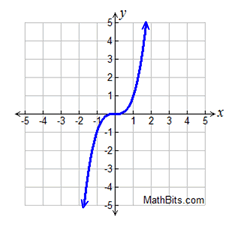 y = x³
y = x³
1 Real Root (repeated) |
 y = x³ - 3x²
y = x³ - 3x²
2 Real roots (1 repeated) |
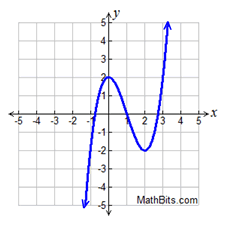 y = x
y = x³ - 3 x² + 2
3 Real roots |
Note: The cubic function will always cross the x-axis at least once, so there will always be at least one real root.
Cubic Function - Transformation Examples:
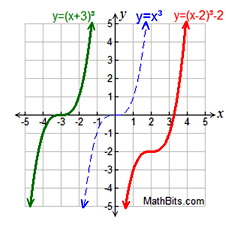 Translations
Translations |
Translations:
Vertical Shift: f (x) + k
Horizontal Shift: f (x + k)
Reflections:
-f (x) over x-axis
f (-x) over y-axis
|
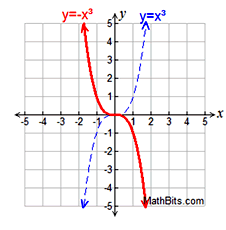
Reflection |
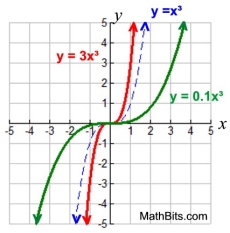
Vertical Stretch/Compress |
Vertical Stretch/Compress
k • f (x) stretch (k > 1)
k • f (x) compress (0 < k < 1)
Horizontal Stretch/Compress
f (k • x) stretch (0 < k < 1)
f (k • x) compress ( k > 1) |
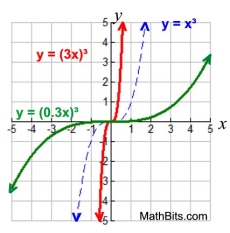
Horizontal Stretch/Compress |

NOTE: The re-posting of materials (in part or whole) from this site to the Internet
is copyright violation
and is not considered "fair use" for educators. Please read the "Terms of Use". |
|

 Shape: Parabola
Shape: Parabola























